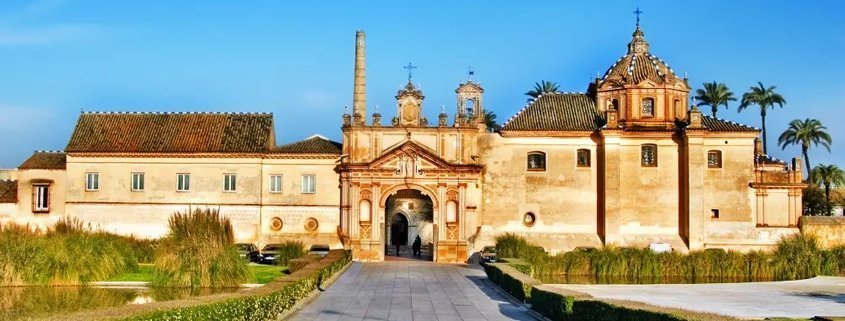The monastery of Santa María de las Cuevas or monasteru of Carthusians
The Marques of Pickman an Englishman who came to live in Seville, saw a good deal on the recently abandoned Carthusian monastery of Santa Maria de las Cuevas. The English porcelain was so fashionable at that time and found its place in Seville in this monastery converted into a ceramics factory. This began in 1841 and lasted more than 100 years. Today we have in the Old Monastery various ceramic panels manufactured here and are especially remarquable the unmistakable baked earthenware ovens.
The Crafts in Seville ceramics date back to Roman empire, and Santa Justa and Santa Rufina, martyrs in Roman times and protective of the city, already manufactured ceramic in Triana, across the river Guadalquivir.
Ceramic was essential in Islamic times for the decoration of palaces and houses. Tiles, tile basin edge … later in Christian times also the tiles were influenced by moorish handicraft but with new Renaissance models and technic. The Italian Niculoso Pisano resident in Triana quarter revolutionized the ceramic art and introduced the painting on flat tile. Some masterpieces of this artist are the Oratory of Isabel the Catholic in the Cuarto Real Alto of Alcázar and the Gate of the Monastery of Santa Paula.
Many years the production center were small and medium workshops at Triana district. But Pickman gave new impetus to the craft and became real industry in the nineteenth century in Seville.

The old monastery
But the monastery already had within its walls a long history before Pickman. It had been founded at the start of the fourteenth century as one of the most important monastic centers of the new Christian Seville. Large extent on the outskirts of Sevilla and looking at the region of Aljarafe was chosen by noble families such as the Riberas for their burials. Christopher Columbus himself stayed here and promoting their friendship with the monks prepared a part of his expedition to the New World. Years after his death his ashes rested in this place for 30 years before leaving for the island of La Española (Dominican Republic) in the Americas. A statue erected by the widow of Pickman remembers the discoverer.
Later in the seventeenth century Francisco de Zurbaran the best painter of monks in the Catholic Spain, full of palaces and convents, left us portraits of the sober and silent Carthusian. This collection of three paintings is now in the Museum of Fine Arts of Seville.
Like so many other convents was the subject of the confiscation and closure in the nineteenth century. That was when Pickman entered the scene and ceramics arrived in the Monastery.
But the history of Santa Maria de las Cuevas continued when the recent and legendary EXPO 92 ‘hosted here the Royal Pavilion.
After 1992, The Cartuja factory dependencies were transfer to another place and the monastery became the Contemporary Art Center after a comprehensive restoration in 1997, retaining function today.
So today we have in this original place an old monastery, a former ceramics factory and the Centro Andaluz de Arte Contemporaneo that programmes temporary exhibitions and concerts.
The charm of the monastery
The monastery is surrounded by the garden of the monks, beautiful full of orange trees and other native plants, it’s perfect to get lost and find tranquility just steps from the center of Seville.
I like the mix of Moorish cloisters with ceramic panels from the nineteenth century made by Pickman. The Renaissance tombs of the Ribera next to contemporary art. I love strolling among ceramic furnaces scattered through the gardens competing in height that give the ancient monastery an unmistakable silhouette.
I like to approach the tree called “Beautiful Shade”, Ombu or Phitolaca Dioecius that, according to tradition, was planted by the son of Christopher Columbus more than 500 years ago.
Also I like cycling through orchards and centenaries orange trees and be amazed with the modern recreation of the giant Alice in Wonderland.
I like the quiet air outside the tumult of the city that should be the same for Carthusian monks centuries ago. And I like to remember the mythical EXPO ’92 that left us a substantial footprint in all Sevillians of more than 35 years.



